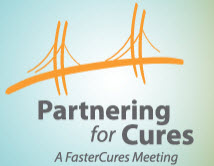Priming the Pump: Filling the Therapeutic Pipeline
Earlier this month, the 3rd annual Partnering for Cures conference was held in New York City. This event, which began in 2009 is organized by FasterCures, a “action tank” that works to improve the medical research system in order to speed up the time it takes to get important new medicines from discovery to patients. ALS TDI is a member of the TRAIN program at FasterCures, which is a subsidiary of the Milken Institute.
To being the conversation, an opening plenary focusing on the convergence of stakeholders in the funding of research. According to conference organizer and FasterCures president and CEO, Margaret Anderson, the FDA approved 35 new therapeutic in 2010; up from the 22 it approved a year earlier. She summed up this growth due to their being strong science, industry leadership and regulatory flexibility. However, Anderson summarized the current pipeline outlook saying, “There is a pipeline issue - they can only review and approve what comes before them. The reason for high approval rate was that these products were in the pipeline years ago. Today, the pipeline isn't as robust. The challenge may be in having too many opportunities but no way to choose or implement or prioritize them.” An excited group of panelists, which included FDA Commissioner Margaret Hamburg, spent the next 90 minutes tackling this topic.
John Mendlien, who is at the helm of several small biotechnology companies, suggested that the focus needs to be on saving time - not necessary about money. To this point, Susan Desmond Hellmann, chancellor of the University of California at San Diego, added that the field needs biomarkers of disease and drug response desperately and the creation of animal models are areas where academics can lead the way. She also reflected that the cost of doing science has lessened as innovation has increased; using the example of the cost of sequencing a person’s genome, dropping to about $2,000 per person from the $95 million it was not too long ago. “It will soon cost less than an MRI, likely within the next year,” said Desmond-Hellmann. This comment led to a lively exchange between several of the panelists, including Mendlein who asked rhetorically and excitedly what the potential opportunities would exist for therapeutic development if every person in the US had their genome sequenced. Responding to this, at the behest of Anderson, Garry Neil, of Johnson & Johnson, interjected that while having data is great it needs to be collected and used in a meaningful way and the collection of such, if done by a private corporation, would provide them a competitive advantage.
Representing the patient advocacy perspective on the panel was Jeff Brewer, the president and CEO of the Juvenile Diabetes Research Foundation (JDRF). He offered these comments, “Incentives are needed for companies to invest in a specific area of research. Partnerships with companies are key for a non-profit foundation.” Brewer then outlined how JDRF has dozens of direct financial relationships and hundreds of other relationships with biotechnology and pharmaceutical companies. “You need to erode the competition between groups working on the same disease especially, when they fund the same researchers and work,” said Brewer. You can view the entire panel discussion online at FasterCures being clicking here or hitting play on the video above.
Back to Basics: Patient Activism : Thirty Years After HIV/AIDS
Another highlight of the first day was the “Back to Basics” panel organized by Susan Love, which can be viewed in its entirely be viewed at the FasterCures website. Warren Lammert, chairman and co-founder of the Epilepsy Therapy Project, and others were invited to provide advice to emerging non-profits on how best to organize and advocate. Lammert’s advice was that each organization needs to have clear ways to measure their success, otherwise you won’t have an impact. His organization for example has decided to focus on ensuring that the pipeline of potential treatments for epilepsy stays robust and therefore they fund projects that were unable to get funding elsewhere from government or other private sources.
ALS Therapy Development Institute, TDP-43 Mouse Model Partnership
Steve Perrin, president, CEO and CSO of the ALS Therapy Development Institute was also invited by the steering committee of this event to present an overview on the $1 million + collaboration between his organization and three others to charectorize an emerging model of neurodegeneration: the TDP43 mouse. The collaboration included both funding and scientific input from the Alzheimer's Drug Discovery Foundation, the Association for Frontotemporal Degeneration and the Muscular Dystrophy Association. Perrin suggested that such partnerships allow for the speeding of research and in turn eventually treatments by working across diseases at the same time rather than focusing each group to do the exact same experiment which would take longer and cost patients and donors more money.
